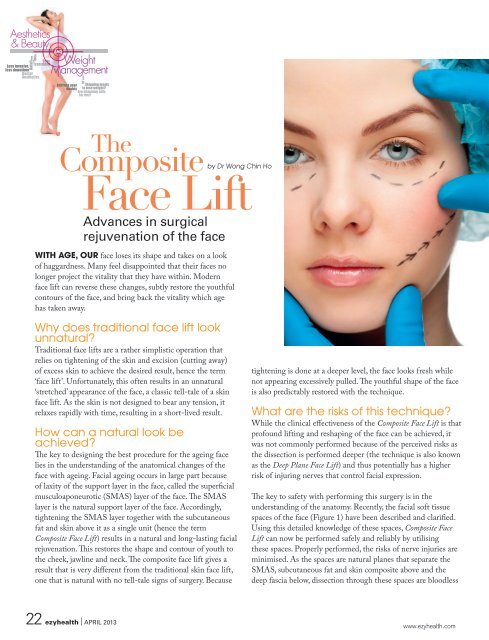Dr Wong Chin Ho - Composite Facelift - W Aesthetics Plastic Surgery
Dr Wong Chin Ho - Composite Facelift - W Aesthetics Plastic Surgery
Dr Wong Chin Ho - Composite Facelift - W Aesthetics Plastic Surgery
Create successful ePaper yourself
Turn your PDF publications into a flip-book with our unique Google optimized e-Paper software.
<strong>Aesthetics</strong><br />
& Beauty<br />
AND<br />
Scar<br />
Treatment Weight<br />
Management<br />
Toxin<br />
Less invasive,<br />
less downtime Botulinum<br />
Dental<br />
<strong>Aesthetics</strong><br />
or diet?<br />
Address your Skipping meals<br />
doubts to lose weight?<br />
Are slimming pills<br />
for me?<br />
The<br />
<strong>Composite</strong>by <strong>Dr</strong> <strong>Wong</strong> <strong>Chin</strong> <strong>Ho</strong><br />
22 ezyhealth | APRIL 2013<br />
Face Lift<br />
Advances in surgical<br />
rejuvenation of the face<br />
WITH AGE, OUR face loses its shape and takes on a look<br />
of haggardness. Many feel disappointed that their faces no<br />
longer project the vitality that they have within. Modern<br />
face lift can reverse these changes, subtly restore the youthful<br />
contours of the face, and bring back the vitality which age<br />
has taken away.<br />
Why does traditional face lift look<br />
unnatural?<br />
Traditional face lifts are a rather simplistic operation that<br />
relies on tightening of the skin and excision (cutting away)<br />
of excess skin to achieve the desired result, hence the term<br />
‘face lift’. Unfortunately, this often results in an unnatural<br />
‘stretched’ appearance of the face, a classic tell-tale of a skin<br />
face lift. As the skin is not designed to bear any tension, it<br />
relaxes rapidly with time, resulting in a short-lived result.<br />
<strong>Ho</strong>w can a natural look be<br />
achieved?<br />
The key to designing the best procedure for the ageing face<br />
lies in the understanding of the anatomical changes of the<br />
face with ageing. Facial ageing occurs in large part because<br />
of laxity of the support layer in the face, called the superficial<br />
musculoaponeurotic (SMAS) layer of the face. The SMAS<br />
layer is the natural support layer of the face. Accordingly,<br />
tightening the SMAS layer together with the subcutaneous<br />
fat and skin above it as a single unit (hence the term<br />
<strong>Composite</strong> Face Lift) results in a natural and long-lasting facial<br />
rejuvenation. This restores the shape and contour of youth to<br />
the cheek, jawline and neck. The composite face lift gives a<br />
result that is very different from the traditional skin face lift,<br />
one that is natural with no tell-tale signs of surgery. Because<br />
tightening is done at a deeper level, the face looks fresh while<br />
not appearing excessively pulled. The youthful shape of the face<br />
is also predictably restored with the technique.<br />
What are the risks of this technique?<br />
While the clinical effectiveness of the <strong>Composite</strong> Face Lift is that<br />
profound lifting and reshaping of the face can be achieved, it<br />
was not commonly performed because of the perceived risks as<br />
the dissection is performed deeper (the technique is also known<br />
as the Deep Plane Face Lift) and thus potentially has a higher<br />
risk of injuring nerves that control facial expression.<br />
The key to safety with performing this surgery is in the<br />
understanding of the anatomy. Recently, the facial soft tissue<br />
spaces of the face (Figure 1) have been described and clarified.<br />
Using this detailed knowledge of these spaces, <strong>Composite</strong> Face<br />
Lift can now be performed safely and reliably by utilising<br />
these spaces. Properly performed, the risks of nerve injuries are<br />
minimised. As the spaces are natural planes that separate the<br />
SMAS, subcutaneous fat and skin composite above and the<br />
deep fascia below, dissection through these spaces are bloodless<br />
www.ezyhealth.com
Facial soft tissue spaces of the face are naturally<br />
occurring spaces that are safe and easily opened<br />
up during surgery. Using a detailed anatomical<br />
understanding of these spaces, the composite facelift<br />
can be performed safely and predictably.<br />
and non traumatic. Using this approach, swelling and<br />
bruising are also minimised (much less than traditional face<br />
lifts) and recovery time from the surgery is much faster.<br />
What areas of the face are<br />
addressed with the <strong>Composite</strong><br />
Face Lift?<br />
The composite facelift addresses the lower face, including<br />
the marionette lines and the jawline. A neck lift is also done<br />
as part of the composite lift. In many patients with midcheek<br />
descent, composite facelift can also be used to lift the<br />
cheek as well as the nasolabial fold. This extended dissection<br />
is called the extended composite face lift.<br />
With these advancements of surgical techniques as<br />
well as the results attainable, we are seeing a renaissance<br />
of surgical face lifts in our practice. The results are better<br />
and more natural, and this can be achieved with reliability<br />
and safety. Ultimately, composite face lift will give you a<br />
different look than that achievable with traditional face lifts.<br />
Patients will look more fresh and vibrant for their age.<br />
www.ezyhealth.com<br />
<strong>Dr</strong> <strong>Wong</strong> <strong>Chin</strong> <strong>Ho</strong> is a <strong>Plastic</strong> Surgeon<br />
at W Aesthetic <strong>Plastic</strong> <strong>Surgery</strong>, Mount<br />
Elizabeth Medical Centre. For more<br />
information, visit www.waesthetics.com.<br />
APRIL 2013 | ezyhealth 23


